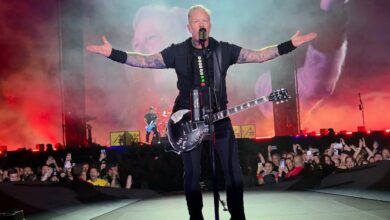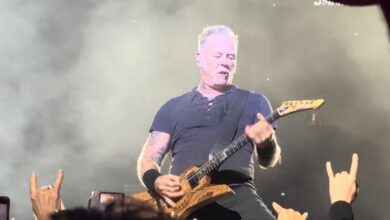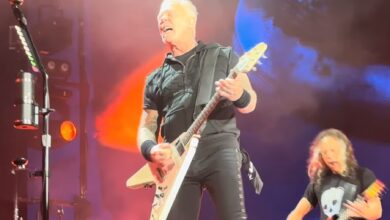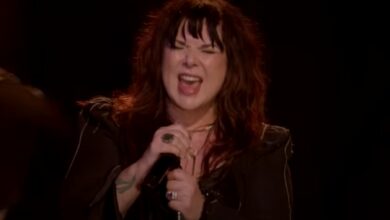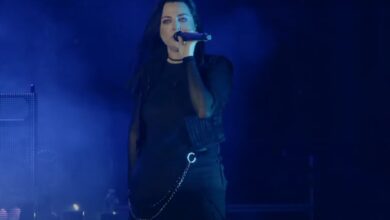Evanescence Dazzle St. Paul with Haunting Performances of “Bring Me to Life” and “My Immortal”
The night stamped itself on calendars long before the first note: Friday, September 19, 2025, Saint Paul, Minnesota. Billed as the 93X Family Reunion, the show brought Evanescence back to downtown with Poppy and Dorothy on a three-act bill engineered to warm, jolt, and then detonate. Doors at 6pm, queues curling around the block, merch moving in armfuls—everything pointed to a packed house hungry for a headliner that can make an arena feel personal. The official listings and radio promos had been buzzing for weeks, so the concourse chatter sounded less like small talk and more like a countdown shared by thousands.
Even before the lights dropped, the room told its own story—Fallen shirts beside The Bitter Truth hoodies, teens with freshly Sharpied tour dates standing next to fans who remember the first time “My Immortal” froze a stadium. That multigenerational spread is Evanescence’s secret accelerant: you get the roar of a legacy act and the edge of a contemporary one. Security hustled but never hassled; ushers swapped tips on which sections usually spark the first singalong. It felt like a reunion by design, the radio station’s brand morphing into a vibe as house music faded and stage haze lifted.
Dorothy hit like a match on dry tinder—blues-grit vocals over hard-charging riffs that turned casual arrivals into fast converts. Then Poppy re-tuned the sound system and the audience’s expectations with glitchy industrial sheen, sharp choreography, and laser-cut hooks. The progression was smart: ignite the floor with heat, then tilt the color palette toward the synthetic and menacing so the headliner’s blend of piano, pulse, and punch would land with maximum contrast. By changeover, the arena had become a pressure cooker—lights low, conversations clipped, phones poised for that first silhouette at center stage.
When Evanescence walked on, the sound snapped into cinema. Amy Lee’s voice arrived both intimate and towering, the kind of placement in the mix where you can hear breath and bravado at once. The openers “Afterlife” and “What You Want” set a muscular pace—tempos tight, guitars articulate rather than just loud, drum transients hitting like punctuation marks. You could feel the FOH crew steering the room, keeping sub-bass from puddling while letting the synth pads widen the walls. Within minutes, the arena conversation turned into collective timing—knowing when to roar and when to hold the air.
The setlist read like a time-travel itinerary, stitching newer material to keystone cuts with deliberate pacing. “Going Under” detonated on cue, a chorus-as-crowd-control moment that tilted the building forward, then “Lithium” cooled the temperature just enough to make the next sprint land harder. The sequencing revealed a band that trusts dynamics more than nostalgia; they didn’t play the museum, they played the room. It’s a small distinction that makes a big difference in an arena, especially when thousands of voices arrive pre-loaded with every lyric.
Saint Paul got a performance of “Bring Me to Life” designed for catharsis rather than mere recollection. The famous piano figure chimed and the floor became a field of raised arms; the verse traveled like a fuse, the pre-chorus tightened, and the chorus collapsed into a single, stadium-sized exhale. The live mix favored clarity over distortion: guitars carried melody lines instead of sitting as wall-of-sound, while the keys laced harmonic glue between kick and snare. It was the kind of arrangement that respects the original while admitting it was built to grow teeth on stage.
Amy Lee conducted the room with micro-gestures—hand arcs cueing swells, a step toward stage left to feed a particularly loud pocket, a glance back that pulled a drum fill a fraction later for dramatic tension. Her vowels opened wide on the hook, riding the arena’s natural reverb without washing out diction; consonants clipped hard enough in the verses to keep urgency high. Watching her you realize how much Evanescence depends on physical phrasing: the voice doesn’t just sing the melody; the body writes the dynamics in real time.
Guitars did heavy melodic lifting, favoring surgical midrange over scooped rumble so counter-lines could stand beside the vocal instead of beneath it. Drums spoke in declarative sentences—tight kick, cracking snare, tom runs that arrived like plot twists rather than filler. Keys and textures—the band’s atmospheric signature—were mixed like cinematography, shading corners but never fogging the frame. In an arena notorious for exposing sloppy EQ, the show sounded curated, like the engineers had pre-imagined exactly where every chorus would bloom.
The crowd functioned as a co-author. Sections traded responsibility for the loudest pre-chorus, and you could pinpoint the instant upper-bowl skeptics converted—phones dropping, hands lifting, faces upturned on a long vowel. From the pit to row Z, the chorus didn’t just echo; it amplified, thickening into harmonies the band could lean on. It’s a peculiar joy of rock rooms in the Midwest: people don’t posture; they participate. By the second run of the hook, the audience wasn’t reacting to the song—they were inside it.
“Going Under,” earlier in the set, telegraphed what “Bring Me to Life” would confirm: this lineup thrives on tension-and-release architecture. Riffs arrive as springboards, verses coil, and choruses crack open like daylight. On “Bring Me to Life,” that structure becomes a communal ritual—call-and-response baked into the writing, dynamics that beg for massed voices, a bridge that feels like a held breath. It’s easy to forget how cleverly the song was engineered for crowds until you’re in one, riding its wave in a room built for hockey and miracles.
Because 2025 is a year of receipts, the show began its second life almost immediately. A fan posted a crisp 4K capture of “Bring Me to Life,” and within hours a playlist stitched Saint Paul’s set into a living archive—multi-angle “What You Want,” a widescreen “Afterlife,” close-mic’d “My Immortal.” The footage didn’t replace the memory; it reinforced it, letting fans measure what they felt against what they heard, and giving anyone who couldn’t make it a surprisingly faithful proxy for the room’s pulse.
Context sharpened the evening’s glow. Two nights later in Louisville, Evanescence would share a headline-grabbing reunion of “Bring Me to Life” with original guest Paul McCoy at Louder Than Life—the first time in nine years they’d staged that exact pairing. Saint Paul wasn’t the viral moment; it was the foundation that made the weekend feel like a narrative arc: prove the song’s present-tense power in Minnesota, then write a footnote for the history books in Kentucky.
Taken as a whole, the Saint Paul performance of “Bring Me to Life” felt like an essay in arrangement. You could isolate each element—piano motif, guitar counter-melody, locked rhythm figures—and still miss the point, which is how precisely they interlock at scale. That’s why the choruses don’t simply get louder; they get larger, as if the room itself is added to the instrumentation. The song has always been a hybrid—gothic timbres, hard-rock engine, pop chassis—and in 2025 it wears that mashup like a tailored suit.
There’s a practical brilliance to the way the show was built around the song without orbiting it. “My Immortal” reset heart rates; “Use My Voice” sharpened focus; “Better Without You” redistributed adrenaline so the late-set anthems could still hit with fresh shock. It’s setlist dramaturgy, really: peaks, plateaus, and a final ascent where “Bring Me to Life” crowns rather than crushes. When bands age into arenas, this kind of pacing becomes the difference between a long show and a great one.
What lingered outside under the September sky wasn’t just the chorus earworm; it was the texture of the evening—the way the kick drum thumped like a heartbeat during the last refrain, the way Lee’s hand cut the air on the final held note, the way strangers finished each other’s favorite-song debates on the walk to the ramp. Everyone leaves with a different highlight; almost everyone agrees on the same thesis: in Saint Paul, “Bring Me to Life” didn’t live in the past. It lived in the room, in the moment, and in the voices that carried it out to the street.
Back home, the 4K clips made the rounds and the comments stacked up—mini-reviews, goosebump timestamps, “I was there” pins, and comparative arguments about mix choices versus previous tours. That’s the modern coda: collective memory forged in real time, then refined online. If you want to know what made the Saint Paul rendition special, you don’t need marketing copy or myth-making. You need a timestamped video, a pair of headphones, and about five minutes to remember what a roomful of people already know.
